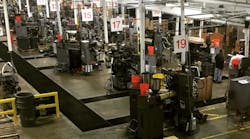So That Happened: Investing in Vinyl, Sleep Is Apparently Optional for CEOs
Editor’s note: Welcome to So That Happened, our editors’ takes on things going on in the manufacturing world that deserve some extra attention. This will appear regularly in the Member’s Only section of the site.
Taking Inventory: US Greenhouse Gas Emissions
Last week the U.S. Environmental Protection Agency released its 30th annual inventory of greenhouse gas emissions, and it showed a not-surprising recent development. Net U.S. greenhouse gas emissions increased by 6% in 2021 over the previous year, a rise the agency attributed to a rebound in economic activity following the height of the pandemic. (For those interested in specific numbers, the net emissions totaled 5,586 million metric tons of carbon dioxide equivalent in 2021.) Since 2005, however, emissions have declined by 17% for a host of reasons, the inventory indicates. The reasons include technology changes, energy market trends, energy efficiency efforts and more.
This annual inventory, which covers the years 1990 to 2021, also breaks out emissions by economic sector. The industrial sector accounted for 24% of U.S. greenhouse gas emissions in 2021. That's slightly less than the transportation sector, which at 29% was the largest contributor in 2021, and the electric power sector, which accounted for 25% in 2021. While the industrial sector's greenhouse gas emissions grew by 1.5% between 2020 and 2021, they have declined by 11% since 1990. Interestingly, a significant influence on the industrial sector's emissions appears to be unrelated to concerted efforts to reduce greenhouse gas emissions. According to the EPA, a shift away from energy-intensive manufacturing to less energy-intensive manufacturing (from steel to computer equipment is an example the agency provides) in the United States has had a major impact.
More detail is available in the complete report. It has been compiled annually since 1993 and is submitted to the United Nations Framework Convention on Climate Change.
That Sounds Nice
May we interest you in an industry that has grown for 17 consecutive years? One that last year shipped nearly 6 million units via some of the country’s biggest brands such as Walmart and Target?
And would you still be interested if we told you it was the pressing of vinyl records?
If you’re still on board, you’re in the company of the Tennessee Department of Economic and Community Development which last week announced it is supporting a $10.8 million expansion of United Record Pressing’s plant a few miles south of downtown Nashville. The project will create about 200 jobs, more than doubling United Record Pressing’s payroll in the Volunteer State.
URP was founded in 1949 as Southern Plastics and bills itself as the oldest and largest vinyl record pressing plant in North America. During its heyday era of the early 1960s, it was cranking out more than 1 million records per month—including the first Beatles 7-inch records in North America—but it unsurprisingly struggled through the latter days of last century as compact discs (remember those?) took over the music business.
Helped by work reissuing some classic albums as well as partnerships with Jack White and a handful of other contemporary artists, it has since bounced back in a big way and today makes 50,000 records per day. That makes it a major player in a business that last year sold more than 43 million albums—but also one that Billboard recently pointed out is growing more slowly.
Gun Detection… In Georgia?
Kia last week announced the installation of a new security system for firearm detection at its plant in West Point, Georgia. The system, called SafeGateway, consists of two person-sized columns an employee walks between before entering the building. Apparently, the system is smart enough to differentiate objects like tablets or walkie talkies from firearms.
The goal was streamlining plant entry by eliminating the need to manually inspect with a metal wand the 9,000 workers entering the plant for every new shift, and according to Kia the new system reduces mean inspection time from 21 seconds to 2.5 seconds per person.
Time is money. Kia plans to install the security system at new manufacturing plants in the future.
Class is in Session: GlobalFoundries Collabs with Rensselaer Polytech
To boost graduation rates for semiconductor engineers and technicians, at least one chip company is heading back to class. GlobalFoundries, the New York-based chipmaker, announced on Monday that it would collaborate with Rensselaer Polytechnic Institute on a new high-level course, Topics in Microelectronics Manufacturing. The class will be taught by engineering professor James Lu of RPI alongside a “team” of experts from GlobalFoundries.
According to a statement from the college, the first semester already has more than 70 students enrolled, which RPI says is “nearly double the typical enrollment for a popular upper-level elective course.”
Though 70 is a high number of enrolled students for the class, those numbers might just be a start for the manufacturing industry. According to GlobalFoundries, the U.S. is projected to need about 50,000 new semiconductor engineers and technicians in the next five years. Competition for engineering talent should be especially fierce in New York with Micron building a $100 billion plant in the state.
Cock-a-Doodle-CEO
Are you CEO material? Well, what time do you wake up? If it’s between 4 a.m. and 6 a.m., you're halfway to the C-Suite.
According to a survey of 500 CEOs by Gordon Simmons, a retired CEO himself (of the largest credit union in New Hampshire), between 5 and 6 a.m. is the most popular time for CEOs (38%) to rise and shine, followed closely by 4-5 a.m. (36%). Outliers wake up either before 4 a.m. (13%) or after 6 a.m. (13%).
So, basically, 87% of leaders of the free world wake up early enough to get a second part-time job on a farm, or at a radio station for the early morning drive shift, or at McDonald’s to whip up the day’s first batch of Egg McMuffins. If these power brokers would only just double up on their occupations, perhaps our nation would be well on its way to solving the labor shortage.







